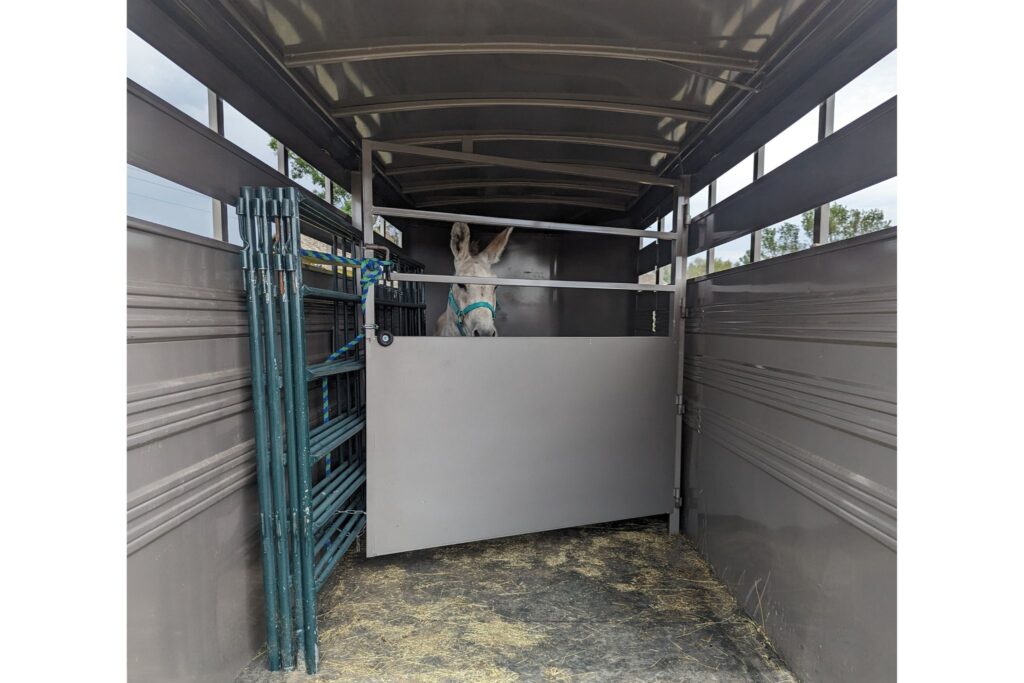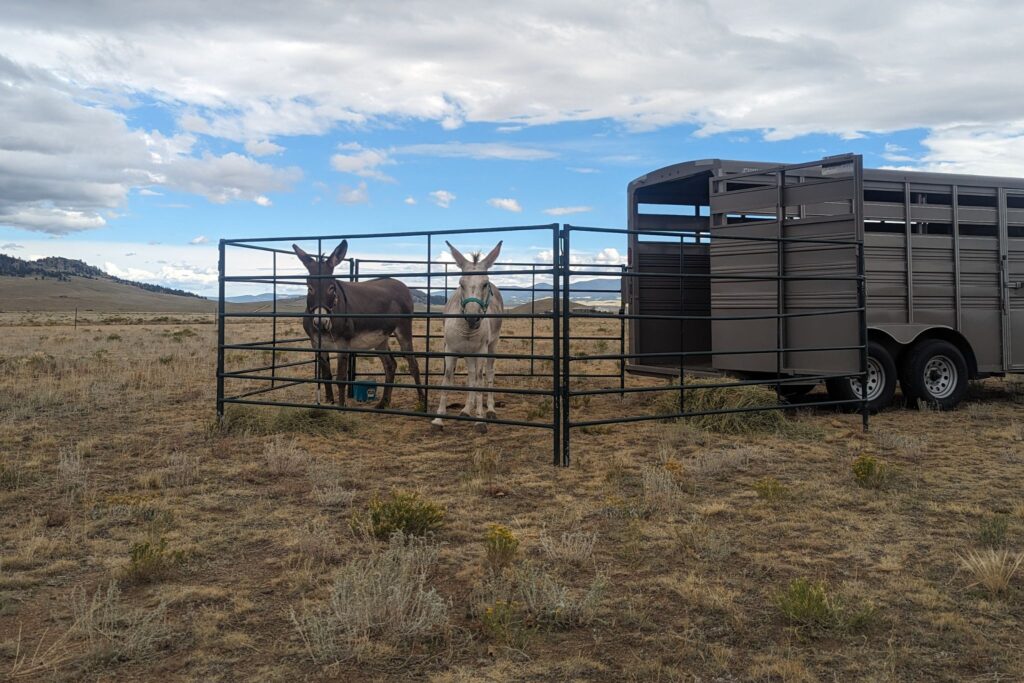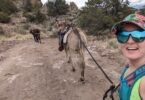Next Time, Bring Your Burro!
Camping with your donkeys can be a great way to get out, explore, and bond with your animal. With the right planning and gear, bringing your burros camping can be a fun, rewarding experience for all.
Preparation
The key to a fun camping weekend is preparation.
As they say “the devil is in the details.”
Bringing your burros along definitely complicates things. Your packing checklist will expand. Equine-friendly camping locations can be hard to come by. Backup plan(s) will be even more important.

Source: Bottomless Backpacks
However, with the right preparation, things can go off without a hitch.
Planning
Location
Know where you’re going. It can be more challenging to find equine-friendly campgrounds and campsites. While dispersed camping is an option, trailer-friendly roads and pullouts may be hard to find.
I like to scout out areas in advance so I know what to expect. This helps me narrow down site selection and minimize my anxiety about navigating unfamiliar roads with a trailer.
It’s always good to have a backup plan.
If things go south, it’s much less stressful to have ready-to-go alternatives!
Route
Pulling a trailer with live animals complicates things. You’ll want to minimize time stopped or sitting and ensure a smooth ride for your burro buddies.

Source: Bottomless Backpacks
I live in Colorado, which means regular weekend mountain traffic.
Traffic can be extra problematic with a trailer.
To minimize delays, I plan to leave earlier (possibly even taking vacation time) or later to minimize the stop-and-go that is inevitable around rush hour. I also check for construction and try to avoid those areas.
Additionally, I’ll avoid dirt roads when there’s a paved option to give the burro boys the smoothest possible ride.
Details
Try to engineer out unnecessary stops to minimize trailer time. Check tire pressure, fill up your vehicle with fuel beforehand, and pack plenty of drinks and snacks.

Source: Bottomless Backpacks
Vehicle Safety Checklist
No one wants to deal with a breakdown, especially not with animals loaded in a trailer. Make sure your vehicle is in tow-ready shape.
- Check tire tread and pressure (on both your towing vehicle and your trailer)
- Ensure all lights (brakes, turn signals, safety) are functioning
- Check oil levels, windshield washer fluid levels, and make sure you have quality windshield wipers for good visibility in inclement weather
Check out a detailed checklist here.
Equine Prep
Packing
When traveling, it’s always better to be over-prepared than under. Here are the things I make sure to pack when hauling my donkeys:
- Extra halter and lead rope (one for each animal)
- Grooming bag
- Pitchfork & muck bucket
- Hay (2x’s what I think I need)
- Grain and feed pans
- Water bucket and at least 5 gallons of water
- Equine first aid kit
- Fly spray
Training
My BLM burro is still half-wild, and trailering is a pretty new thing. He’s handled it very well, but I make sure to spend a little time training on loading/unloading before a trip to make sure we’re both confident.
I desensitized my donkeys to tents in advance by setting up / taking down a tent repeatedly in their corral.

Source: Bottomless Backpacks
Then, I left the tent setup for several weeks so they could get used to all the noises it makes in the wind. This definitely paid off for our first camping trip! Moon was completely unphased by our tents.
Equine Passport
Equines in Colorado need a brand inspection if you’re traveling more than 75 miles from home. I just got a permanent travel card for Moon, which is much more convenient than calling for a brand inspection each time we want to head into the mountains!
If you’re crossing state lines, you’ll need a health certificate and Coggins test within the last 30 days.
Execution
You’ve planned, you’ve prepped…now it’s time for a road trip!
Loading
We load the trailer a little differently for a road trip vs. day trip. We use four 10′ metal panels to create a corral around the back of the trailer for camping. This way, the donkeys can safely move around at-will.
The panels fit along the left inner trailer wall and are secured at the bottom with chains and at the top with a ratchet strap.

I wouldn’t do this with a horse! Source: Bottomless Backpacks
Eventually, I’ll get brackets welded to the outside of the trailer so we can transport these things on the exterior vs. interior.
The last thing I do is load animals—I don’t want them standing around inside the trailer any longer than they need to be!
We haul the donkeys loose, so they can decide how to best stand to balance in the trailer. Sometimes, they’ll lock themselves together for increased stability.
Trip Checks
If we do stop for gas or a bathroom break, we make sure to first check our animals. For my BLM burro, I like to closely monitor his stress levels to see how he’s handling the trip. Is he sweating? Shaking? Can I see the whites of his eyes?
Trailering can be stressful, and it’s my job to make it as easy on him as possible.
A good test is—will he take a carrot?
Carrots are a good source of fiber and moisture, and if Moon is willing to munch on a snack, he’s not really that stressed out. If he refuses food, then I know he’s maxed out.
Each trip he goes on gets better and better!
Arrival
Once again, the first priority is always the donkeys. As soon as we arrive, we immediately unload the donkeys and tie them to the trailer. Then, we set up the fence panels to form a corral.

Source: Bottomless Backpacks
We’ll re-use the ratchet strap to secure the door open so the wind can’t move it. Then, using the four panels we brought, we can quickly assemble a corral. With a practice run, we can build our corral in less than 10 minutes!
Once the corral is set up, we put the donkeys inside and offer them hay and water. They are able to go into the trailer for shelter if needed, and the trailer/door combination can also act as a wind barrier.
Departure
Be a good steward for future equine campers! Be sure to practice Leave No Trace principles and pack out everything–trash, manure, etc. My goal is to always leave a camping area better than I found it.
With the right research, preparation, and attitude, anything is possible!
Frequently Asked Questions:
Q: How do you find equine-friendly camping?
There are a variety of resources out there, but it certainly isn’t as easy as finding a campsite for people. I do a lot of Google searches, ask friends, and look for dispersed camping options that will be easily accessible with a trailer.
I found this particular campsite on AirBNB—it was advertised as Boondock Campsite and trailer-friendly. I messaged the host in advance to be sure she was OK with us bringing our burros, and it worked out great!
This particular campsite was a fenced-in 5 acre lot which added an extra layer of security.
Q: What size stock trailer is good for donkeys?
I have a 16′ stock trailer with a center divider that creates two, 8′ box stalls. This setup has worked great! It’s nice to be able to separate burros, or I have plenty of space to haul gear if the donkeys can ride together.
If given the option, always load the donkeys in the front stall and gear in the back.
While this complicates pre-loading the trailer, it’s a smoother and safer ride for the donkeys closer to the hitch. The trailer will travel better with more weight loaded towards the front rather than behind the axles.

Source: Bottomless Backpacks
Parting Thoughts
With a little planning, you and your burro buddies can get geared up for a fun, safe camping experience!
P.S. Enjoy this article? Trot on over to:
- Horse Insurance: What, Why, & How Much
- Equine Preventative Care: How to Head Off Issues, Early
- 5 Simple Steps to Halter Training Your Wild Donkey
- Safety First: How Much Can a Donkey Carry?
- 13 Best Treats and Toys for Busy-Minded Donkeys
- How to Adopt a Wild Donkey: A Helpful Beginner’s Guide







